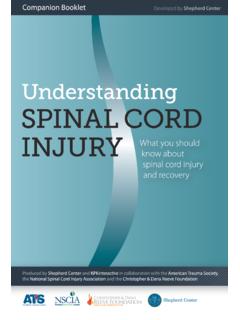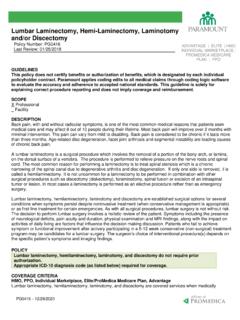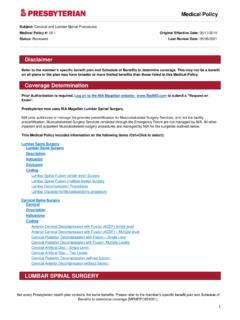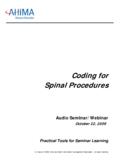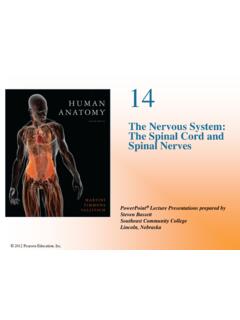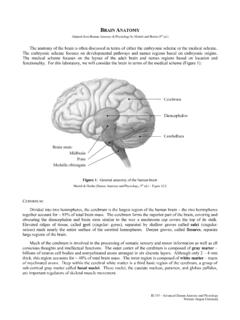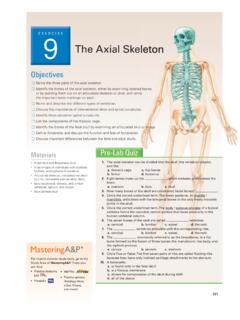Transcription of Table of Contents - Spinal Cord Injury
1 Spinal Cord Injury : Basic Facts ..1 Spinal Column Anatomy: The Basics ..3 Levels of Injury ..4 ASIA/ISCoS Exam and Grade ..8 Glossary of Terms You May Hear ..9 Questions Families Should Ask Their ..11 Trauma Care Medical TeamExpected Emotions and Helpful Coping Tips ..12 Important Tips for the Days and Weeks ..13 After the Injury or DiagnosisSteps to Negotiate the Insurance Maze ..14 Helpful Resources, and Credible Organizations and Web Sites ..16 Table of Contents1 Spinal CORD Injury : BASIC FACTSS pinal Cord Injury : Basic FactsSpinal cord Injury occurs when there is any damage to the Spinal cord that blocks communication between the brain and the body. After a Spinal cord Injury , a person s sensory, motor and reflex messages are affected and may not be able to get past the damage in the Spinal cord. In general, the higher on the Spinal cord the Injury occurs, the more dysfunction the person will experience.
2 Injuries are referred to as complete or incomplete, based on whether any movement and sensation occurs at or below the level of most important and sometimes frustrating thing to know is that each person s recovery from Spinal cord Injury is injuriesMotor vehicle accidents FootballFalls GymnasticsViolence Diving into shallow waterSpinal cord injuries affect more men than women. The majority of people who sustain a Spinal cord Injury are young adults between the ages of 16 and 30 because of riskier injuries/illnessesCancer OsteoporosisMultiple sclerosis Inflammation of the Spinal cordArthritisContinued on Next Page2 UNDERSTANDING Spinal CORD INJURYEFFECTSThe effects of Spinal cord Injury may include the following: Loss of movement Loss of sensationLoss of bowel and/or bladder controlExaggerated reflex actions or spasmsChanges in sexual function, sexual sensitivity and fertilityPain or intense stinging sensationSpinal Cord Injury : Basic Facts Continued from Page 1 When a Spinal cord Injury occurs, sensation and movement may be interrupted, resulting in a temporary or permanent loss of function, paraly-sis and loss of sensation.
3 Here are some basic anatomy facts:n The brain is surrounded by the The Spinal cord is surrounded by rings of bonecalled Both are covered by a protective membrane. n Together, the vertebrae and the membrane make upthe Spinal column, or The backbone, which protects the Spinal cord, starts atthe base of the skull and ends just above the hips. n The Spinal cord is about 18 inches long. It extends fromthe base of the brain, down the middle of the back, to just below the last rib in the waist The main job of the Spinal cord is to be the communication system between the brain and the body by carrying messages that allow people to move and feel sensation. n Spinal nerve cells, called neurons, carry messages to and from the Spinal cord, via Spinal Messages carried by the Spinal nerves leave the Spinal cord through openings in the vertebrae.
4 N Spinal nerve roots branch off the Spinal cord in pairs, one going to each side of the body. n Every nerve has a special job for movement and feeling. They tell the muscles in the arms, hands, fingers, legs, toes, chest and other parts of the body how and when to move. They also carry messages back to the brain about sensations, such as pain, temperature and COLUMN ANATOMY: THE BASICSS pinal Column Anatomy:The Basics4 UNDERSTANDING Spinal CORD INJURYV ertebrae are grouped into higher the Injury on the Spinal cord,the more dysfunction can Nerves (C1 C4)n Most severe of the Spinal cord Injury levelsn Paralysis in arms, hands, trunk and legsn Patient may not be able to breathe on his or her own, cough, or control bowel or bladder Ability to speak is sometimes impaired or When all four limbs are affected, this is calledtetraplegia or Requires complete assistance with activities ofdaily living, such as eating, dressing, bathing, and getting in or out of bedn May be able to use powered wheelchairs withspecial controls to move around on their ownn Will not be able to drive a car on their ownn Requires 24-hour-a-day personal careLevels of InjuryC1C2C3C4C5C6C7C85 LEVELS OF INJURYLow-Cervical Nerves (C5 C8)
5 N Corresponding nerves control arms and A person with this level of Injury may be able to breathe on their own and speak C5 injuryo Person can raise his or her arms and bend Likely to have some or total paralysis of wrists, hands, trunk and legso Can speak and use diaphragm, but breathing will be weakenedo Will need assistance with most activities of daily living, but once in a power wheelchair, can move from one place to another independentlyn C6 injuryo Nerves affect wrist Paralysis in hands, trunk and legs, typicallyo Should be able to bend wrists backo Can speak and use diaphragm, but breathing will be weakenedo Can move in and out of wheelchair and bed with assistive equipmento May also be able to drive an adapted vehicleo Little or no voluntary control of bowel or bladder, but may be able to manage on their own with special equipmentn C7 injuryo Nerves control elbow extension and some finger Most can straighten their arm and have normal movement of their Can do most activities of daily living by themselves, but may need assistance with more difficult taskso May also be able to drive an adapted vehicleo Little or no voluntary control of bowel or bladder, but may be able to manage on their own with special equipmentn C8 injuryo Nerves control some hand Should be able to grasp and release objectso Can do most activities of daily living by themselves, but may need assistance with more difficult taskso May also be able to drive an adapted vehicleo Little or no voluntary control of bowel or bladder.
6 But may be able to manage on their own with special equipmentContinued on Next Page6 UNDERSTANDING Spinal CORD INJURYL evels of Injury Continued from Page 5 Thoracic vertebrae are locatedin the Nerves (T1 T5)n Corresponding nerves affect muscles, upper chest, mid-back and abdominal muscles. n Arm and hand function is usually Injuries usually affect the trunk and legs(also known as paraplegia).n Most likely use a manual wheelchairn Can learn to drive a modified carn Can stand in a standing frame, while othersmay walk with bracesThoracic Nerves (T6 T12)n Nerves affect muscles of the trunk(abdominal and back muscles) depending on the level of Usually results in paraplegian Normal upper-body movementn Fair to good ability to control and balancetrunk while in the seated positionn Should be able to cough productively(if abdominal muscles are intact)n Little or no voluntary control of bowelor bladder but can manage on their own with special equipmentn Most likely use a manual wheelchairn Can learn to drive a modified carn Some can stand in a standing frame,while others may walk with OF INJURYL umbar Nerves (L1 L5)n Injuries generally result in some loss of functionin the hips and legs.
7 N Little or no voluntary control of bowel or bladder, but can manage on their own with special equipmentn Depending on strength in the legs, may need awheelchair and may also walk with bracesSacral Nerves (S1 S5)n Injuries generally result in some loss of functionin the hips and legs. n Little or no voluntary control of bowel or bladder, but can manage on their own with special equipmentn Most likely will be able to walkL1L2L3L4L5(S1 S5)This is a system of tests used to define and describe the extent and severity of a patient s Spinal cord Injury and help determine future rehabilitation and recovery needs. It is ideally completed within 72 hours after the initial Injury . The patient s grade is based on how much sensation he or she can feel at multiple points on the body, as well as tests of motor function.*ASIA/ISCoS Exam Chart (ASIA Impairment Scale)Grade AGrade BGrade CGrade DGrade EComplete lack of motor and sensory function below the level of Injury (including the anal area)Some sensation below the level of the Injury (including anal sensation)Some muscle movement is spared below the level of Injury , but 50 percent of the muscles below the level of Injury cannot move against (more than 50 percent) of the muscles that are spared below the level of Injury are strong enough to move against neurologic function has Spinal CORD INJURYASIA/ISCoS Exam and Grade9 GLOSSARY OF TERMS YOU MAY HEARA rteriovenous malformation Misconnection between the arteries andthe veinsASIA/ISCoS Exam and Grading System System to describe Spinal cord Injury and help determine future rehabilitation and recovery needs.
8 It is based on a patient s ability to feel sensation at multiple points on the body and also tests motor function. Ideally, it s first given within 72 hours after the initial Dysreflexia Potentially life-threatening condition caused by painful stimuli below the level of Injury that the body cannot respond to because of non-functioning nerve cells (especially in people with complete tetraplegia). Symptoms include painful headache due to a sudden increase in blood pressure, slowed heart rate, increased or abnormal sweating, red blotches on the skin and restlessness. It s important to be alert for causes, such as an overfull bladder, impacted stool, infected pressure ulcers or even ingrown Injury No function or sensation below the level of the injuryCT Scan (Computerized Tomography) Provides doctors with more detailed information about Spinal cord or brain damage than X-rays can showIncomplete Injury Some sensory or motor function below the primary level of the injuryHealthcare advocate A person who works directly for the patient or family for a fee, helping with paperwork, billing and management of post-trauma care Hemorrhage Internal or external bleeding caused by damage to ablood vesselMotor Function Ability to control muscles voluntarily and their resultant useMotor Index Score (MIS)
9 A portion of ASIA/ISCoS exam that determines muscle strength of 10 different muscles on both sides of the body Glossary of Terms You May HearContinued on Next PageMRI (Magnetic Resonance Imaging) Uses a strong magnetic field and radio waves to produce computer-generated images. It can help identify blood clots, swelling or skull fractures that may be compressing the brain and/or the Spinal cord. Myelography A test using injected dye to help the doctor visualize your loved one s Spinal nerves more clearly. After the dye is injected into the Spinal canal , X-rays and CT scans of the vertebrae can reveal herniated disks or other problems. Occupational therapist Skilled in helping individuals learn, or relearn, the day-to-day activities they need to achieve maximum independenceParaplegia Paralysis, or loss of motion.
10 It typically affects the trunk and both legs, but not the arms. This is usually a result of injuries at the thoracic and lumbar levels. Physiatrist Doctor specializing in physical medicine and rehabilitationPhysical therapist Treats disabilities that result from motor andsensory impairments Recreational therapist (or therapeutic recreation specialist) Helps patients discover the wide range of recreational options they may be able to participate in and trains them to do soRehabilitation nurse Nurse with special training in rehabilitative and restor-ative medicineTetraplegia (also quadriplegia) Paralysis from approximately the neck down. It results from Injury to the Spinal cord in the neck and is associated with total or partial loss of function in both arms and Index Score (SIS) Part of ASIA/ISCoS exam that measures patient s response to light touch and a pinprick in 28 points on each side of the body to determine what the patient can feel.
